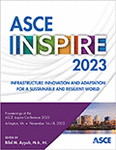An Optimized Target Reliability Index for Solar PV Structures Considering Excess Mortality due to Structural Failure-Related Power Outage
Publication: ASCE Inspire 2023
ABSTRACT
An economical and tactical transition to renewable energy sources is critical for social welfare and national security. Construction of utility-scale solar photovoltaic (PV) plants is accelerating this transition. Solar PV structural behavior differs from typical building behavior in many ways. However, these structures are designed under the prescriptive provisions of existing building codes that do not recognize, or account for, the unique characteristics and risks associated with solar PV structures. The motivation for this study is to calculate an optimal solar-specific reliability index and compare it to the existing building code reliability targets to either validate or to suggest improvements to current structural design practice. The methodology involves application of a recently published target reliability index procedure where cost optimization and human safety are considered separately. This approach also permits the unique life safety implications of utility-scale solar PV plants to be explicitly captured by the reliability index and, therefore, the structural design. There are no occupant-related life safety risks associated with utility-scale solar PV plants. However, there is a power generation function life safety risk. That risk is captured herein as excess mortality due to solar PV structural failure-related power outage. The resulting solar-specific reliability index is then compared with the current prescriptive building code reliability targets. The results demonstrate that for the current inventory of utility-scale solar PV plants, the prescriptive building code reliability targets are excessively conservative. The provisions require a structural safety expenditure that does not result in measurable increases to social welfare. The associated cost penalties decelerate the transition to renewable energy by limiting the scope and scale of new solar infrastructure investment. The advantages commensurate with the solar-specific reliability indices presented in this paper can be captured by applying the performance-based procedures in the existing building codes to solar PV structures. This approach includes flexibility to adjust the solar-specific reliability indices proportional to the national inventory size and individual project scale as the transition progresses, thus, promoting the fastest transition to renewable energy with explicit management of life safety risk, while ensuring economy, social welfare, and national security.
Get full access to this article
View all available purchase options and get full access to this chapter.
REFERENCES
ASCE. (2022). Minimum Design Loads and Associated Criteria for Buildings and Other Structures, Standard ASCE/SEI 7-22. ASCE, Reston, VA.
Anderson, G. B., and Bell, M. L. (2012). “Lights Out: Impact of the August 2003 Power Outage on Mortality in New York, NY.” Epidemiology. 23 (2), 189–193.
Bolinger, M., Seel, J., Warner, C., and Robson, D. (2022). “Utility-Scale Solar, 2022 Edition.” Accessed June 27, 2023. https://emp.lbl.gov/sites/default/files/utility_scale_solar_2022_edition_slides.pdf.
CDC (Centers for Disease Control and Preventions). (2023). “Deaths and Mortality.” Accessed June 27, 2023. https://www.cdc.gov/nchs/fastats/deaths.htm.
Duffin, E. (2022). “Average size of households in the U.S. 1960-2022”. Accessed June 27, 2023. https://www.statista.com/statistics/183648/average-size-of-households-in-the-us/.
Ellingwood, B., Galambos, T. V., MacGregor, J. G., and Cornell, C. A. (1980). “Development of a probability-based load criterion for American National Standard A58.”, National Bureau of Standards, Gaithersburg, MD.
Hafmeister, D. (2007). Physics of societal issues – Calculations on national security, environment, and energy. Springer, New York, NY.
Hamburger, R. O. (2010). The Performance Basis for ASCE 7-10. Modern Steel Construction, American Institute of Steel Construction (AISC), Chicago, IL.
ICC (International Code Council). (Forthcoming). International Building Code (IBC 2024), International Code Council (ICC), Washington, D. C.
Kelly, R., Huang, J., Poulos, H., and Stewart, M. G. (2021). “Geotechnical and Structural stochastic analysis of piled solar farm foundations.” Computers and Geotechnics, https://doi.org/10.1016/j.compgeo.2020.103988.
Liu, L., Yang, D. Y., and Frangopol, D. M. (2021). “Determining Target Reliability Index of Structures Based on Cost Optimization and Acceptance Criteria for Fatality Risk.” J. Risk Uncertainty Eng. Syst., https://doi.org/10.1061/ARUA6.0001127. 04021013.
Madsen, H. O., Krenk, S., and Lind, N. C. (2006). Methods of structural safety. Dover, Mineola, NY.
Melchers, R. E., and Beck, A. T. (2018). Structural reliability - analysis and prediction, 3rd Edition. Wiley, New York, NY.
Murphy, L. M. (1980). “Wind Loading on Tracking and Field Mounted Solar Collectors.” Solar Energy Research Institute (SERI), Golden, CO.
McAllister, T. P., Wang, N., and Ellingwood, B. R. (2018). “Risk-Informed Mean Recurrence Intervals for Updated Wind Maps in ASCE 7-16.” J. Struct. Eng, https://doi.org/10.1061/(ASCE)ST.1943-541X.0002011. 06018001.
SEIA (Solar Energy Industries Association). (2023). “What’s in a Megawatt?” Accessed June 27, 2023. https://www.seia.org/initiatives/whats-megawatt.
EIA (US Energy Information Administration). (2023). “What is U.S. electricity generation by energy source?” Accessed June 27, 2023. https://www.eia.gov/tools/faqs/faq.php?id=427&t=1.
Information & Authors
Information
Published In
History
Published online: Nov 14, 2023
ASCE Technical Topics:
- Building codes
- Building design
- Business management
- Construction engineering
- Construction management
- Design (by type)
- Electric power
- Energy engineering
- Energy sources (by type)
- Engineering fundamentals
- Infrastructure
- Lifeline systems
- Power outage
- Practice and Profession
- Public administration
- Public health and safety
- Renewable energy
- Safety
- Solar power
- Standards and codes
- Structural design
- Structural reliability
- Utilities
Authors
Metrics & Citations
Metrics
Citations
Download citation
If you have the appropriate software installed, you can download article citation data to the citation manager of your choice. Simply select your manager software from the list below and click Download.
